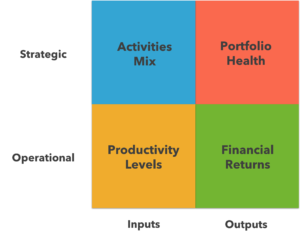Innovation metrics are hard. Casual observers typically assume that innovation, as a “fuzzy” art, can’t be measured at all. This is an unfortunate belief, because it unduly complicates innovation’s crucial role in driving firm-wide value.
Although measuring innovation is possible – and necessary for success – it’s still a touchy subject for most innovation leaders. There are four reasons why.
Innovation is new to the business and ambiguous. For the vast majority of companies, innovation is either an occasional or newfound discipline. Making it into a repeatable, scalable set of practices tends to highlight organizational roadblocks and politics – even with deft, careful leadership. The conversation about innovation metrics can be polarizing.
Innovation is inherently unknown. Most innovation leaders face a difficult challenge when translating the potential value of ideas into quantitative measures. While a common reaction is to go straight to the bottom line with measures such as ROI, innovators know these metrics can kill early-stage promising concepts. The organization must develop a comfort level with ambiguity as a means to learn key lessons along the way.
Innovations have long time horizons. Measuring transformative innovations is an exercise in patience. Potential new products that are mere concepts today may take years to enter the market, and even longer to demonstrate ROI. Very few innovation programs have the luxury of waiting multiple years before delivering quantifiable results.
Measuring innovation requires partners. Demonstrating the effects of a strong innovation program typically depend on active involvement from other units and functions in the company. For example, innovation is also leveraged to drive culture change – but how is that really being measured and monitored? At the very least, this implies a strong partnership with the HR and Operations functions, to create the environment where such questions can be answered. These interdependent partnerships are net-new when building an innovation program, and not always obvious.
Very few innovation programs have the luxury of waiting multiple years before delivering quantifiable results.
Because innovation metrics are difficult to unravel, we’re asked about them on a weekly basis. Teams are looking to understand what to measure, what others are measuring, what really matters, and why. Through the years, we’ve learned there are four key types of metrics that mature innovation programs utilize.
To unpack which metrics to use when, it’s helpful to categorize them along two dimensions – Inputs vs Outputs, and Operations vs Strategy.

Financial Returns – the path to legitimacy
The first few years of a formal innovation program are a critical period. Future success depends on whether the innovation group can demonstrate or “prove” its value to the company.
Because most organizations already have an abundance of metrics and KPIs in active use, it may be tempting for innovation leaders to measure everything from the beginning. Although well intentioned, the “measure everything” approach should be resisted, at least initially.
It’s far better to start with a few simple, carefully-chosen metrics. Ideally, they’re adapted from tangible and data driven measures already in widespread use within the organization. This helps
multiple stakeholders get comfortable with innovation’s activities from the outset, driving internal credibility and influence up-front.
Tracking financial returns is the best lever for gaining trust and influence. They’re typically variantions on familiar themes: measuring new revenue generated (topline oriented) or costs saved and efficiencies gained (bottom-line oriented). These metrics send the most unequivocal, unassailable signals to leadership and the organization about how innovation efforts are faring.
The specific choice of financial metrics depends on how your company’s innovation strategy dovetails with organizational goals and KPIs. The early metrics focus areas will also be driven by which innovation activities can be measured most readily, and which leaders or functions are most willing to partner with the innovation group. Common examples include:
Cost Savings
Process efficiencies
Incremental revenues
Learn about these financial return metrics in The 4 Types of Innovation Metrics paper.
These incremental value metrics act as a bridge between the time when the innovation program launches, and when the value of new-to-the-world products, services, and customer experiences can be established.
It’s important to understand incremental innovation is simply a place to begin, and that a mature program includes a blended portfolio of adjacent and transformational innovations as well.
Productivity Levels – priming the pump
In the early days, it’s also important to gain a handle on innovation’s productivity levels – primarily as an internal barometer for the health of the program’s balance of activities.
Typically, these metrics track throughput across each stage of the ideas to innovation cycle. These measures look at overall volume of the pipeline:
Ideation volume
Engagement levels
Projects launched
HR-oriented measures
Functional metrics
Board-level consideration
Learn about these productivity metrics in The 4 Types of Innovation Metrics paper.
Portfolio Health – reaching a higher gear
Elite athletes undergo rigorous training regimens to convert natural talent into world-class results. They develop the ability to “reach another gear” – attaining extraordinary performance well beyond their untrained capacity.
We’ve observed a similar phenomenon with innovation programs.
After several years of development and maturation, it’s common to approach an upper limit on innovation’s potential impact.
To reach an elite level, comparatively pedestrian measures of baseline operational results are no longer sufficient. Diversification into a balanced portfolio of short-, mid-, and long-term innovation bets is necessary.
At this point, innovation’s ability to generate financial returns should no longer be in question. Along with other mature corporate functions, innovation now plays an instrumental role in leading the charge for overall growth and corporate success. Strategic objectives, and corresponding metrics, are pivotal.
Typically, measuring the strategic layer of an innovation program means assessing portfolio health. Bigger, more impactful bets come with longer payback periods and higher degrees of uncertainty. Lagging indicators such as validated financial returns are not useful in placing and executing these bets. By the time you know the score, the game is over.
Thus, tracking the portfolio is predictive rather than retroactive, thus tied to a synthetic understanding of long-term ecosystem trends:
Customers
Technologies
Ecosystem
Learn about these trends impacting Portfolio Health in The 4 Types of Innovation Metrics paper.
A holistic view of these trends provides an evolving yardstick by which to measure innovation portfolio health. You can start with a lightweight approach by creating a foundational innovation strategy based on validated views of these trends. From there, qualitative assessments of the portfolio are possible through spider-grams, progress meters, and other executive dashboards.
Even better, use scenario modeling as the foundation of your innovation strategy. Running simulations based on models of the future will indicate whether the portfolio of innovation projects, if carried forward, will contribute materially to expected strategic imperatives over time. Although somewhat heavier, the scenario-based approach provides both added flexibility, analytical rigor, and a substantially augmented predictive richness.
Activities Mix – securing the future
Expanding the activities mix is pivotal as innovation evolves into a mature function. Many programs begin simply, by crowdsourcing ideas and executing on projects. That’s a fine start. But for innovation to protect the firm’s strategic interests, you need to have a more complete set of capabilities in place, including:
Trend scouting
Incubation
Co-creation
Scale-up
Learn more about these metrics in The 4 Types of Innovation Metrics paper.
Using Innovation Metrics in Practice
Shrewd innovation executives continuously keep score of their progress, and then calibrate metrics to fit their program’s current level of sophistication and staying power.
To learn how to use the innovation metrics in practice, read The 4 Types of Innovation Metrics paper.









Comments are closed.